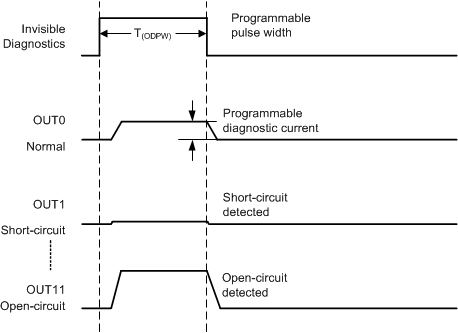SLVSFZ4A December 2020 – February 2021 TPS929121-Q1
PRODUCTION DATA
- 1 Features
- 2 Applications
- 3 Description
- 4 Revision History
- 5 Device Comparison Table
- 6 Pin Configuration and Functions
- 7 Specifications
-
8 Detailed Description
- 8.1 Overview
- 8.2 Functional Block Diagram
- 8.3
Feature Description
- 8.3.1 Device Bias and Power
- 8.3.2 Constant Current Output
- 8.3.3 PWM Dimming
- 8.3.4 On-chip 8-bit Analog-to-Digital Converter (ADC)
- 8.3.5
Diagnostic and Protection in Normal State
- 8.3.5.1 Fault Masking
- 8.3.5.2 Supply Undervoltage Lockout Diagnostics in Normal State
- 8.3.5.3 Low-Supply Warning Diagnostics in Normal State
- 8.3.5.4 Reference Diagnostics in Normal State
- 8.3.5.5 Pre-Thermal Warning and Overtemperature Protection in Normal State
- 8.3.5.6 Communication Loss Diagnostic in Normal State
- 8.3.5.7 LED Open-Circuit Diagnostics in Normal State
- 8.3.5.8 LED Short-Circuit Diagnostics in Normal State
- 8.3.5.9 On-Demand Off-State Invisible Diagnostics
- 8.3.5.10 On-Demand Off-State Single-LED Short-Circuit (SS) Diagnostics
- 8.3.5.11 Automatic Single-LED Short-Circuit (AutoSS) Detection in Normal State
- 8.3.5.12 EEPROM CRC Error in Normal State
- 48
- 8.3.6
Diagnostic and Protection in Fail-Safe States
- 8.3.6.1 Fault Masking
- 8.3.6.2 Supply UVLO Diagnostics in Fail-Safe States
- 8.3.6.3 Low-supply Warning Diagnostics in Fail-Safe states
- 8.3.6.4 Reference Diagnostics at Fail-Safe States
- 8.3.6.5 Overtemperature Protection in Fail-Safe State
- 8.3.6.6 LED Open-circuit Diagnostics in Fail-Safe State
- 8.3.6.7 LED Short-circuit Diagnostics in Fail-Safe State
- 8.3.6.8 EEPROM CRC Error in Fail-safe State
- 58
- 8.4 Device Functional Modes
- 8.5 Programming
- 8.6 Register Maps
- 9 Application and Implementation
- 10Power Supply Recommendations
- 11Layout
- 12Device and Documentation Support
- 13Mechanical, Packaging, and Orderable Information
8.3.5.9 On-Demand Off-State Invisible Diagnostics
It is commonly required to ensure there is no fault on each LED load before lighting them up, especially for LED animation. Otherwise, the LED fault is detected in the middle of the admiration pattern, which results a random and uncertain failure animation pattern. The TPS929121-Q1 provides a solution to diagnose the LED open-circuit or LED short-circuit fault without lighting up the LEDs. With this feature, the master controller can initiate the on-demand invisible diagnostics before commencing the animation sequence. If one of the channel fails, the device is able to detect it immediately instead of only when the fault channel is turned on in traditional diagnostics mode. To initiate the on-demand invisible diagnostics, the master controller writes register CONF_INVDIAGSTART to 1. The register CONF_INVDIAGSTART returns to 0 automatically in the next clock cycle. Once the diagnostics started, the on-demand diagnostics ready flag FLAG_ODREADY is cleared to 0. Once the diagnostics finished, the FLAG_ODREADY is set to 1. If any channel has output failures, its on-demand diagnostic flag FLAG_ODDIAGCHx is set 1.
To ensure the invisibility of the diagnostics, the TPS929121-Q1 outputs only a small DC current in short period to each output channel and detects if there is any LED open-circuit or LED short-circuit failures. The output DC current I(ODIOUT) can be adjusted to a proper value by setting the DC current CONF_ODIOUT and ignoring the DC current setup by register CONF_IOUTx. The pulse-width T(ODPW) of output DC current can be programmable by CONF_ODPW and neglecting duty cycle configuration by register CONF_PWMOUTx. At the end of the current output pulse, if there is any LED open-circuit fault as LED Open-Circuit Diagnostics in Normal State described, the TPS929121-Q1 pulls the ERR pin down with one pulsed current sink for 50 µs to report fault and set flag registers including FLAG_OPENCHx, FLAG_OUT and FLAG_ERR to 1. If there is any LED short-circuit fault as LED Short-Circuit Diagnostics in Normal State described, the TPS929121-Q1 pulls the ERR pin down with one pulsed current sink for 50 µs to report fault and set flag registers including FLAG_SHORTCHx, FLAG_OUT and FLAG_ERR to 1. The master controller must write 1 to CLR_FAULT register to clear fault flags after the fault removal is verified by another on-demand off-state invisible diagnostics. TI recommends turning off all output channels by set CONF_ENCHx to 0 before invisible diagnostics.
For invisible diagnostics mode, it is required to have a short-pulse and low output current to avoid lighting up LEDs. However, the diagnostics are strongly affected by large loading capacitance. If the invisible diagnostics pulse failed to charge output capacitance above short-circuit threshold, the device reports a false short-circuit failure. If pulse failed to charge output above open-circuit threshold at maximum supply voltage, the device does not report open-circuit fault correctly. Thus, the DC current and period of the detection pulse must be carefully selected based on the capacitance value at output in real application.
 Figure 8-4 Programmable Invisible Diagnostics Timing Sequence
Figure 8-4 Programmable Invisible Diagnostics Timing Sequence